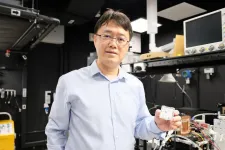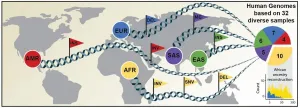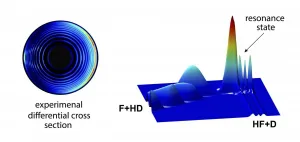(Press-News.org) An international team of scientists has developed a system that can generate random numbers over a hundred times faster than current technologies, paving the way towards faster, cheaper, and more secure data encryption in today's digitally connected world.
The random generator system was jointly developed by researchers from Nanyang Technological University, Singapore (NTU Singapore), Yale University, and Trinity College Dublin, and made in NTU.
Random numbers are used for a variety of purposes, such as generating data encryption keys and one-time passwords (OTPs) in everyday processes such online banking and e-commerce to shore up their security.
The system uses a laser with a special hourglass-shaped cavity to generate random patterns, which are formed by light rays reflecting and interacting with each other within the cavity. By reading the patterns, the system generates many series of random numbers at the same time (see Image 1).
The researchers found that like snowflakes, no two number sequences generated using the system were the same, due to the unpredictable nature of how the light rays reflect and interact with each other in the cavity.
The laser used in the system is about one millimeter long, smaller than most other lasers. It is also energy efficient and can be operated with any household power socket, as it only requires a one-ampere (1A) current.
In their study published in one of the world's leading scientific journals Science on 26 February 2021, the researchers verified the effectiveness of their random number generator using two tests, including one published by the US National Institute of Standards and Technology.
The research team has proven that the NTU-made random number generator which is faster and more secure than existing comparable technologies, could help safeguard users' data in a world that is steadily relying more on Internet transactions (see Image 2).
Professor Wang Qijie from NTU's School of Electrical and Electronic Engineering & School of Physical and Mathematical Science, as well as The Photonics Institute, who led the NTU team involved in the international research, said, "Current random number generators run by computers are cheap and effective. However, they are vulnerable to attacks, as hackers could predict future number sequences if they discover the algorithm used to generate the numbers. Our system is safer as it uses an unpredictable method to generate numbers, making it impossible for even those with the same device to replicate."
Dr Zeng Yongquan, a Research Fellow from NTU's School of Physical and Mathematical Sciences, who co-designed the laser system, said: "Our system surpasses current random number generators, as the method can simultaneously generate many more random sequences of information at an even faster rate."
The team's laser system can also generate about 250 terabytes of random bits per second - more than a hundred times faster than current computer-based random number generators.
At its speed, the system would only take about 12 seconds to generate a body of random numbers equivalent to the size of information in the largest library in the world - the US Library of Congress.
Elaborating on the future of the system, the team is working on making the technology ready for practical use, by incorporating the laser into a compact chip that enables the random numbers generated to be fed directly into a computer.
INFORMATION:
As Covid-19 impacts lives around the world- a new skeleton study is reconstructing ancient pandemics to assess human's evolutionary ability to fight off leprosy, tuberculosis and treponematoses with help from declining rates of transmission when the germs became widespread.
The researchers state the germs mutated to infect ancient humans so they could replicate- hopping across to as many new hosts as possible- but the severity of the diseases reduced as a result.
The analysis by Adjunct Professor in Archaeology Maciej Henneberg and Dr Teghan Lucas at Flinders ...
In 2001, the International Human Genome Sequencing Consortium announced the first draft of the human genome reference sequence. The Human Genome Project, as it was called, had taken more than eleven years of work and involved more than 1000 scientists from 40 countries. This reference, however, did not represent a single individual but instead is a composite of humans that could not accurately capture the complexity of human genetic variation.
Building on this, scientists have carried out many sequencing projects over the last 20 years to identify and catalog genetic differences between an individual and the reference genome. Those differences usually ...
A chemical reaction can be understood in detail at the quantum state-resolved level, through a combined study of molecular crossed beam experiments and theoretical quantum molecular reaction dynamics simulations.
At a single collision condition, the molecular crossed beam apparatus is able to detect the scattering angle-resolved product with rotational state-resolution. Whereas, with accurate global potential energy surface, quantum reactive scattering theory is able to predict the corresponding reactive scattering information.
In previous studies, the chemical reaction dynamics was revealed only with the product rotational state-resolution. And the investigation of a reaction ...
Although the value of vaccines for COVID-19 may seem obvious, government action and investment in vaccines have not been commensurate with the enormous scale of benefits they offer, argue Juan Camilo Castillo and colleagues in this Policy Forum. Since even one extra month of exposure to COVID-19 kills hundreds of thousands, reduces global gross domestic product (GDP) by hundreds of billions of dollars, and generates large losses to human capital by harming education and health, expanding vaccine capacity even further would generate substantial global benefits. Castillo et al. report results of two related exercises: estimating the global benefits from vaccine capacity already in place, and estimating the benefits ...
The pandemic has made clear the threat that some viruses pose to people. But viruses can also infect life-sustaining bacteria and a Johns Hopkins University-led team has developed a test to determine if bacteria are sick, similar to the one used to test humans for COVID-19.
"If there was a COVID-like pandemic occurring in important bacterial populations it would be difficult to tell, because before this study, we lacked the affordable and accurate tools necessary to study viral infections in uncultured bacterial populations," said study corresponding author Sarah ...
Bladder cancer is more aggressive and more advanced in South Texas residents than in many parts of the country, a study by the Mays Cancer Center, home to UT Health San Antonio MD Anderson, indicates.
The disease is also deadlier in Latinos and women, regardless of where they live nationwide, according to the research.
The team from The University of Texas Health Science Center at San Antonio (UT Health San Antonio), which includes the Mays Cancer Center, compared bladder cancer cases in the Texas Cancer Registry with cases in the Surveillance, Epidemiology and End Results (SEER) Program. SEER, which collects data on cancer cases from various locations and sources across the U.S., does not include Texas statistics.
Cases covered the years ...
A Skoltech researcher has developed a theoretical model of wave formation in straits and channels that accounts for nonlinear effects in the presence of a coastline. This research can improve wave prediction, making maritime travel safer and protecting coastline infrastructure. The paper was published in the journal Ocean Dynamics.
Predicting surface weather at sea has always been a challenging task with very high stakes; for instance, over 4,000 people died due to rough seas during Operation Overlord at Normandy in June 1944, an allied incursion where poor forecasting altered the course of the operation quite significantly. Current wave forecasting models used, for example, by NOAA in the US, are imperfect, but they have many tunable parameters to ensure a reasonably good prediction.
However, ...
Low blood levels of immune cells called lymphocytes, in combination with higher levels of inflammation on PET/CT scans, are indicators of active sarcoidosis -- an inflammatory disease that attacks multiple organs, particularly the lungs and lymph nodes -- which disproportionately affects African Americans. The discovery by researchers at the University of Illinois Chicago could help guide disease treatment. Their findings are published in the journal Frontiers in Medicine.
The researchers were looking for biomarkers -- both in the blood and in PET/CT scan findings -- ...
Large carnivores are generally sensitive to ecosystem changes because their specialized diet and position at the top of the trophic pyramid is associated with small population sizes. This in turn leads to lower genetic diversity in top predators compared to animals lower down the food chain. Genetic diversity is very important for a species' ability to survive and adapt to future changes.
Extraordinary genetic diversity in an extraordinary cat
In this study, the researchers sequenced the complete genome of 53 African leopards and compared them to the Amur leopards and other big cat species. To their surprise, the researchers found that the genetic diversity of African leopards is extremely high: Almost four times ...
Per- and polyfluoroalkyl substances (PFAS) are a class of man-made chemical compounds and a current, emerging concern to environmental health. PFAS substances have unique characteristics-resistance to heat, water, oil and stains-that make them useful in a variety of industrial applications and popular in consumer goods. Many PFAS are stable and long-lasting in the environment, acquiring the name "forever chemicals." Industrial use of some of these compounds has been halted; however, many derivatives are still in commerce and more are under development. PFAS are now found in many compartments of the environment.
In ...




